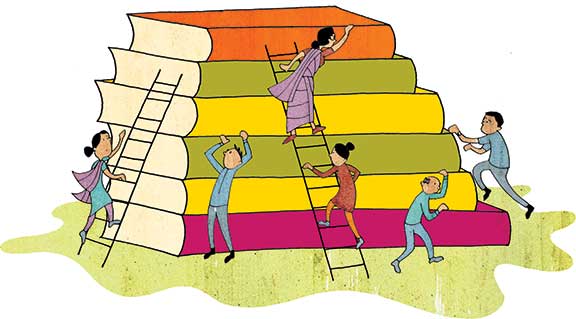Rishabh Kumar Mishra
Learning enriches experiences, engages with surroundings, and activates the cognitive, affective and social potential of an individual. These facets of learning are supposed to be an integral part of intentional as well as incidental learning. However, the learning that happens through schools has been jargonized as ‘learning burden’ in educational literature. Stakeholders including the state, administrators, teachers and parents, are constantly searching for a way to make learning burden-free. All the reports and reviews followed by policy decisions contain several reasons and steps that can lead to supposed solutions but the learning burden has become phenomenal and deep-rooted in our conscious and unconscious memory as lived reality of school years. One can smell pessimism in these lines but it is only a genuine concern to explore this problem that plays on the most creative years of a child.
 When one learns in an everyday setting, i.e., while cooking, driving, or playing cricket, one feels the inherent joy of learning. Learning that takes place outside the walls of the school is incidental but joyful. Learning that takes place in the classroom is intentional but gives the impression that it is ‘not’ joyful. Implications of this observation lead us to question the ‘intentions’ behind classroom learning. The constructors of this intentional environment of learning will not agree that there is a problem in the supposed intention itself, which is holistic development, development of personality, nurturing interest and creativity, providing quality schooling with useful knowledge, etc. These intentions may be genuine and show the stakeholders’ commitment but their execution leaves much to be desired. Let’s peep into history to see the relationship between burden and learning.
When one learns in an everyday setting, i.e., while cooking, driving, or playing cricket, one feels the inherent joy of learning. Learning that takes place outside the walls of the school is incidental but joyful. Learning that takes place in the classroom is intentional but gives the impression that it is ‘not’ joyful. Implications of this observation lead us to question the ‘intentions’ behind classroom learning. The constructors of this intentional environment of learning will not agree that there is a problem in the supposed intention itself, which is holistic development, development of personality, nurturing interest and creativity, providing quality schooling with useful knowledge, etc. These intentions may be genuine and show the stakeholders’ commitment but their execution leaves much to be desired. Let’s peep into history to see the relationship between burden and learning.
There are texts written by well-known scholars such as Dharampal, Vidya Niwas Mishra, Pormesh Aacharya, and Krishna Kumar discussing an earlier system before the advent of modern schooling in India. Although the system was criticized for many reasons, nevertheless it was also appreciated for reflecting the socio-cultural milieu of the learners. The modern school system in India was installed by the British Raj as a formal institution of learning. For them, it was a tool of the state with an outlook of social welfare agency. This social welfare was understood in terms of opportunities one could get after being educated in that system. The opportunity to mobilize oneself in society, to earn a secure livelihood with an identity of ‘VIP’ under the aegis of the British Raj was accepted and appreciated with a burdened learning environment. The burden was popularized at the cost of individual growth and development. This discontinuity between the world presented in schools and the world that is out there still prevails and is very well institutionalized. In fact, schools have become institutions of bridging the gap between a powerful group and a powerless group through what we might refer to as ‘powerful’ knowledge. Those with power have authority to define what is powerful knowledge. And the rest of the people have to struggle to earn this power through knowledge. Powerful knowledge provided by schools ensures the crossing of this bridge and inculcates attitudes and behaviours of the elite. The phenomenon of powerful knowledge, just discussed, is an unsaid experiential reality of our education system. Every parent dreams of an elite world and children who grow up in the Indian tradition are committed to cross this bridge as soon as possible. Thus, the intervention of ‘burden with learning’ is accepted and validated as a procedural burden that is institutionalized and celebrated as a symbol of schooled identity.
Let’s turn the lens to the learners’ side. There is no doubt about the curiosity, imagination, and activeness of a child. Her carrying capacity is enormous and constantly evolving. She engages herself in the meaning-making process with an open heart and mind. The cognitive processes, i.e., sensing, perceiving, attaining, storing, and retrieving are in situ and help her to take her natural and social surroundings in cognizance. Her interaction with other social beings is also multilateral and meaningful. Thus, a child with a spectrum of experiences and with a curious mind equips herself with lots of psychological and social tools by engaging herself in vivid learning environments. The popular terms ‘child-centered education’ and ‘activity-based education’ promise to stimulate the natural urge for learning in an individual. The slogan is misinterpreted by the practitioners. Child centered education does not mean to fit the child into the frame designed by the teacher. It means to devise pedagogic tools that tap the cognitive and socio-cultural capabilities of the learners.
Try and observe a child who is centered in the process of learning. You will find that our classroom processes do not take into account ‘a child’ but acknowledge a group of homogeneous children identified by their socio-economic class and stratified as per their social class status in a multi-layered school system in India, i.e., elite public schools or convent schools following in the footsteps of these elite schools, government-run public schools, etc. In this scenario, a child is understood in terms of her social and communal identity and unfortunately her experiences of being a part of the socio-cultural context are not acknowledged. She is left with an unused reservoir of knowledge. Activity-based learning is another myth. It is executed with an exhaustive list of projects and assignments prescribed by the schools and demand a lot of resources that can only be bought. You can find stationary shops in each and every locality supplying glue-sticks, sparkle pens, colour pages, ribbons of different sizes and colours. Every evening the shops are crowded with anxious parents and their curious kids to buy the stuff that is necessary for completing the projects. Sometimes, boards with information, i.e., ‘Hamare yahan summer project bhi banaye jate hain’ or ‘readymade summer projects are available here’ tagged outside such shops show the gravity of the problem. These activities have created an artificial surrounding around the learner where creativity is readymade. Creativity is actually about expression and imagination mediated through novel experiments and ideas. Now, being creative has become another burden and learners share this burden with their parents to prove that only they are the creative ones.
The rapid spread of urbanization and metropolitan culture has changed the rhythm of a child’s life. This influence has spread to small towns and villages as well. Everywhere parents are in a hurry to institutionalize the socialization of their kids under different learning environments. The market is cashing in on the tendency to showcase hobby centres, sports coaching centres, dance and music centres, etc. These things are all necessary but they are becoming a ‘must’ in a child’s daily routine. Just imagine a day of a child – five to six hours in school, one to two hours in tutorial classes, hobby or some other classes at weekend. Expectations as well as pressure of performance are rising everyday and children are trying hard to cope. There is no problem with the carrying capacity of the learners but there is a problem with the learning process that is not using the learners’ fund of everyday knowledge. Instead of tracking the experiential world, we have burdened ourselves to create a school world. This school world is present in our social sphere with universal and valid evidence of grade sheets or performance descriptions/statements, mirroring the learners’ identity. One has to grow up with the schooled identity. It is not what you are but what the mirror reflects.
Ah! But don’t make the teacher the culprit of the problem. She is the actor who has to perform under the systemic chains. She stands at the zone that can or can’t be fertile depending on the nature of inputs that she gets. These inputs in the form of the directives from the administrators at the policy level, channelize the course of action by the teachers. The filtered messages at each step increase the velocity of demand to be performed by the teacher. The process converts a teacher into a ‘curriculum chaser’ who firmly believes that she is an actor without acknowledgement. She has to share the demands with her learners because the efficiency of a teacher is measured by the impact of learning that her learners show on the occasion of assessment. In addition, the evidences of responsibilities and accountabilities are observed through classroom acts that have to be fitted within the norms of schools. Everybody is skeptical about her acts and she is answerable to any of the problems related to teaching and learning. Teachers are treated as hired professionals to execute the act of teaching, whereas they are intellectual professionals engaged in the process of knowledge co-construction. The epistemic nature of their work and their contribution as epistemic beings is not considered. Therefore, teaching becomes an act of completing the syllabus and learning becomes an act of burdening the learners’ cognitive, social and affective domains. We should ask a question to ourselves ‘to whom and what do we want to prove? and why? Every individual is an independent being born with natural instincts for learning and he/she learns at his/her own pace. We, as significant others, can monitor and keep track of his/her trajectory but cannot dictate the process.
We need to rethink the ontological assumptions of learning as held and practiced in schools. Learning in schools is not a process of meeting some ends defined in terms of indicators signalling the success of an individual in future. Learning is a process of exploration of the self with the vistas of creativity, guided by passion and scaffolded with empathetic hands.
The author is Assistant Professor at Mahatma Gandhi Antarrashtriye Hindi Vishwavidyalaya, Wardha. He can be reached at rishabhrkm@gmail.com.

